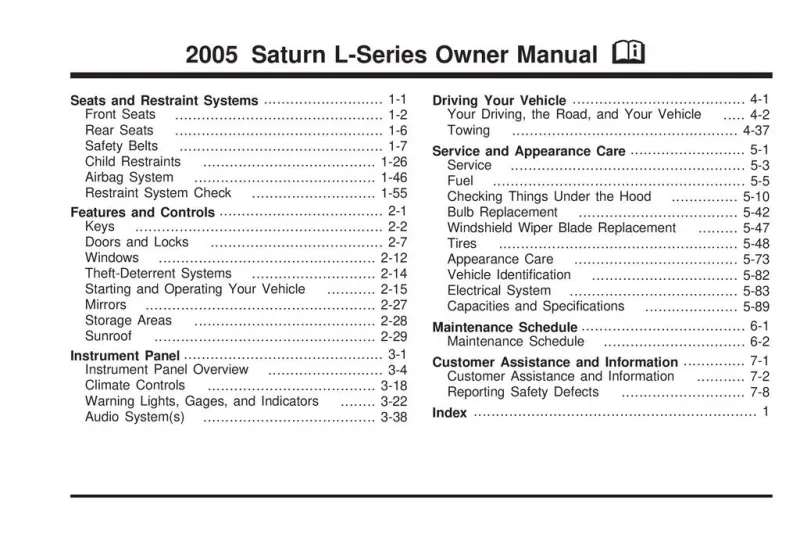2005 Saturn L Series Owner's Manual

Table of Contents
2005 Saturn L Series Overview
Introduction
The 2005 Saturn L Series stands out as a reliable and affordable midsize sedan that appeals to families and commuters alike. With its spacious interior, solid performance, and commendable fuel efficiency, the L Series is designed to meet the needs of daily drivers while ensuring a comfortable ride. Building on a legacy of practicality and innovation, this model reflects Saturn's commitment to customer-centric design.
Powertrains
The 2005 Saturn L Series offers two engine options that cater to varying performance requirements. The base L300 is equipped with a 2.2-liter four-cylinder engine, generating 135 horsepower and providing excellent fuel economy for everyday driving. For those seeking a bit more power, the L300 also features a 3.0-liter V6 engine, which delivers an impressive 182 horsepower. Both engines are paired with a smooth-shifting four-speed automatic transmission, ensuring seamless acceleration and responsive handling on the road.
Trims
The L Series lineup comprises several trim levels, including the L200 and L300, allowing buyers to select the features that best suit their lifestyle. The L200 trim focuses on affordability while still offering essential components, such as air conditioning, power windows, and keyless entry. The L300, on the other hand, elevates the experience with premium features, including leather upholstery, a sunroof, and an upgraded sound system, catering to those who desire added luxury in their travels.
Features
In addition to its powertrains and diverse trim options, the 2005 Saturn L Series comes equipped with a range of thoughtful features designed for convenience and safety. Standard safety elements include front and side airbags, as well as anti-lock brakes. Additionally, the spacious cabin incorporates ample storage solutions, comfortable seating for up to five passengers, and available options like a navigation system, enhancing every journey.
Owner's Manual
The owner's manual for the 2005 Saturn L Series is an invaluable resource for new owners, providing detailed information on maintenance schedules, troubleshooting tips, and technical specifications. It encompasses a user-friendly layout that guides owners through operating various features, ensuring they can maximize their experience with the vehicle while maintaining its peak performance over the years.
User manual download
The Saturn L Series owner manual for the 2005 model year is to be found in PDF downloadable format on this page. The owner manual for the model year 2005 is free and in English, but the repair manuals are usually not easy to get and may cost more.
Manual Questions
Fill the form below and someone will help you!
